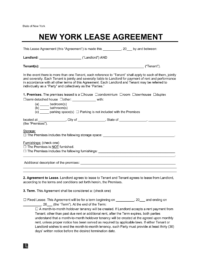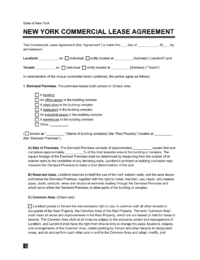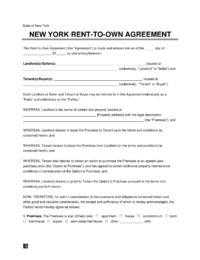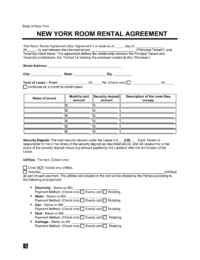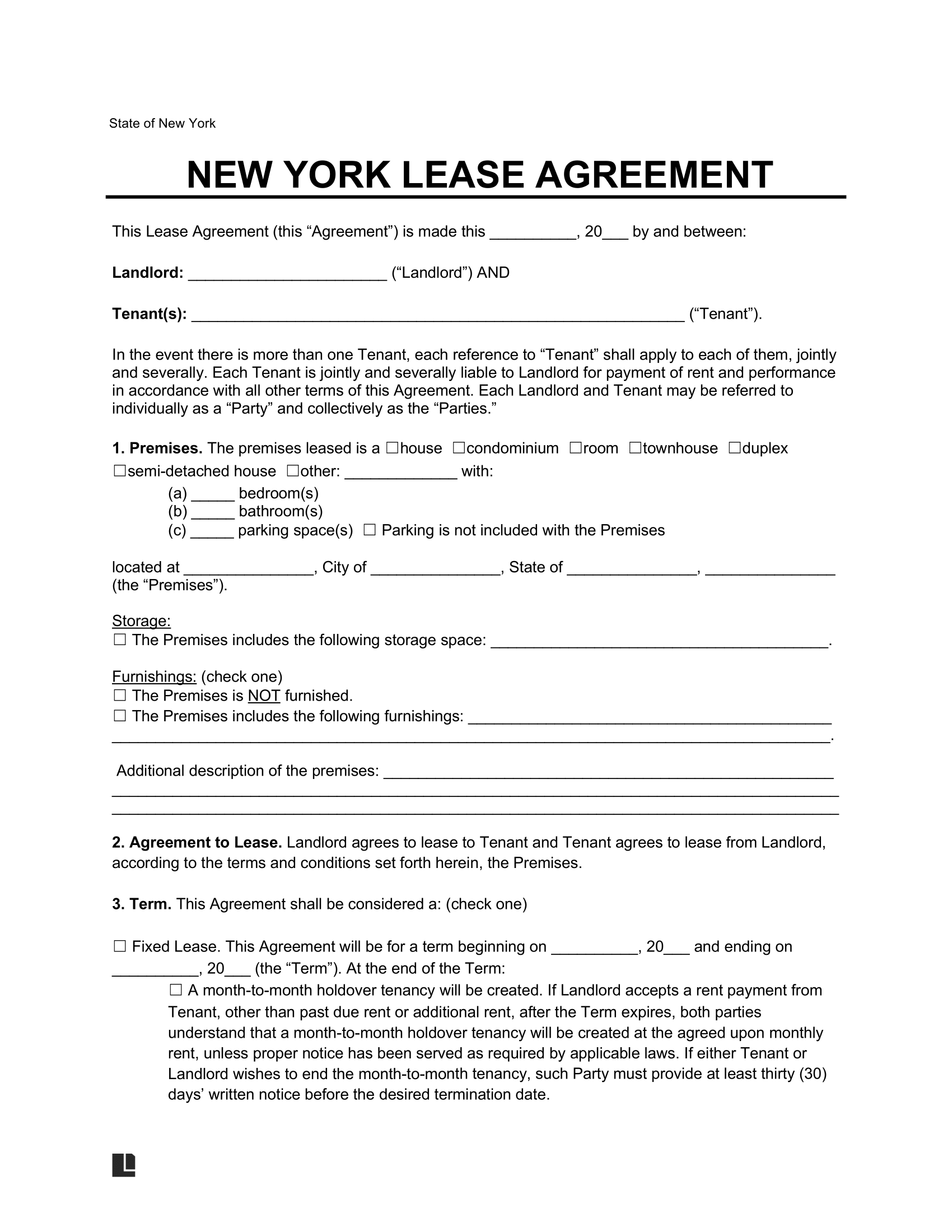What Is a New York Lease Agreement?
A New York lease agreement is a legally binding contract between a landlord and a tenant that outlines the terms for renting a property and the responsibilities of both parties. This document covers essential details such as:
- Names of the landlord and tenant
- Property address and description
- Rent amount and due date
- Lease length or duration
- Security deposit terms
- Required disclosures
- Rules for pets, smoking, and more
Most residential lease agreements in New York are for a fixed term of one year. While oral agreements are legally valid for leases shorter than one year, any lease lasting one year or longer must be in writing to be enforceable under NY General Obligations Law § 5-703(2). Upon expiration of the lease term, the rental agreement will automatically convert to a month-to-month tenancy under state law, unless a new agreement is signed.
Before signing a lease, landlords can use a New York rental application to screen tenants.
New York Landlord-Tenant Laws Overview
| Topic | Rule | NY Rule |
|---|---|---|
| Rent Control | Only specific units in NYC and a few other cities are rent-stabilized or rent-controlled. Rules limit the annual rent increase. | New York Attorney General's Residential Tenants' Rights Guide |
| Rent Due & Late Fees | Rent is considered late after 5 days. The maximum late fee is $50 or 5% of the rent, whichever is less. | RPL § 238-a |
| Grace Period | No mandatory statewide grace period. But rent isn't considered later until after 5 days. | RPL § 238-a |
| Rent Receipts | The landlord must provide a written rent receipt if the tenant pays in cash or by money order. | RPL § 235-e |
| Security Deposit | Landlords may charge up to one month's rent as a security deposit. | GOL § 7-108 |
| Deposit Handling | Must be held in a separate bank account. For buildings with six or more units, the deposit must earn interest (minus a 1% administrative fee). | GOL § 7-103 & § 7-105 |
| Notice of Rent (Increase/ Non-Renewal) | Landlords must provide 30, 60, or 90 days' notice, depending on the length of time the tenant has lived in the unit. | RPL § 226-c |
| 5-Day Late Rent Notice | Landlords must notify tenants in writing if rent has not been received within 5 days of the due date. | RPL § 235-e |
| Warranty of Habitability | Landlords are required to maintain safe and livable conditions. Tenants may be eligible for a rent reduction in case conditions are not met. | RPL § 235-b |
| Landlord Entry | Entry is allowed for repairs or inspections with reasonable notice. Providing 24 hours of written notice is best practice, except in the case of an emergency. | New York Attorney General's Residential Tenants' Rights Guide |
| Required Disclosures | Must disclose sprinkler system status, lead-based paint (if applicable), and flooding risks. | RPL § 231-a, RPL § 231-b,42 US Code § 4852d |
New York Lease Agreement (By Type)
There are several New York lease agreement formats available to meet different rental needs. Whether you’re renting out a home, room, or commercial space, each type below offers a customizable contract that you can use to stay compliant with New York rental laws.
New York Standard Lease Agreement
Formalizes a rental agreement between a landlord and a tenant for residential property.
New York Commercial Lease Agreement
Creates a landlord-tenant arrangement for renting property for commercial purposes.
New York Rent-to-Own Lease Agreement
Permits a tenant to buy property from a landlord after their lease term.
New York Month-to-Month Rental Agreement
Renews on a rolling basis without a specific end date.
New York Sublease Agreement
Creates an additional lease agreement while the initial tenant retains their responsibility towards the original landlord.
New York Room Rental Agreement
Specifies living terms and financial obligations for tenants renting separate rooms within the same property.
New York Security Deposit Rules
New York limits the amount a landlord can collect and has strict rules regarding how security deposits must be handled. These rules protect tenants and ensure transparency when it comes to holding rental deposits.
Maximum Deposit Amount
Landlords cannot change more than one month’s rent as a security deposit, regardless of the lease term. This rule applies to all residential leases, including those that are renewed (GOL § 7-108(1-a)).
Rules for Holding the Security Deposit
Security deposits must not be mixed with the landlord’s personal funds (GOL § 7-103).
Bank and Interest Requirements
If the buildings have six or more units, the deposit must be placed in a New York interest-bearing bank account. The tenant should receive any interest earned, minus a 1% annual administrative fee that the landlord can keep. Landlords should also provide the tenant with a written notice of the bank’s name and address where the deposit is held (GOL § 7-103).
Returning the Deposit
The security deposit must be returned within 14 days after the tenant vacates the premises. If the deposit is withheld, the landlord must provide an itemized list of deductions that clearly indicates why it is being retained. If the landlord fails to meet the 14-day deadline, they must return the full deposit, even if the tenant caused damage or owes money (GOL § 7-108(1-b)).
Security Deposit on Property Sale
If the rental property is sold, the landlord must either transfer the deposit to the new owner or return it to the tenant within five days, providing written notice (GOL § 7-108).
Valid Reasons to Withhold a Deposit
A landlord may legally withhold part of the security deposit if the tenant:
- Owes unpaid rent or utility bills
- Caused damage beyond normal wear and tear
- Violates the lease terms
Rent Rules and Payment Terms in New York
Understanding when rent is due, what fees apply, and how notice rules work is essential for both landlords and tenants in New York. These laws help clarify expectations and prevent conflict or misunderstandings during a lease.
Rent Due Date and Grace Period
Rent is due on the date stated within the lease agreement. New York does not set a universal due date.
Late Fees and Grace Period
In New York, a 5-day grace period is required before a landlord can charge a late fee. (RPL § 238-a). The landlords must send a written notice to the tenant stating that the rent is late. The maximum late fee that can be charged is $50 or 5% of the rent, whichever is less.
Application and Screening Fees
Landlords may charge application fees to cover the costs associated with tenant background checks and screening. However, all fees must be reasonable and disclosed in advance. The fees cannot exceed the actual cost of screening or $20, whichever is less (RPL § 238-a(1)(b)).
Rent Increase and Non-Renewals
If a landlord plans to raise the rent by 5% or more or not renew the lease, they must give a written notice(RPL § 226-c). The required notice is based on how long the tenant has lived in the unit, such as:
- 30-day notice if the tenant has lived there for less than one year
- 60-day notice for 1-2 years
- 90-day notice for more than 2 years
NSF (Bounced) Check Fees
Issuing a bad check in New York is a class B misdemeanor (Penal Law § 190.05). Landlords are allowed to charge a reasonable fee if a rent check is returned due to insufficient funds. However, this only applies if the cost is specified in the initial lease.
Landlord’s Right of Entry in New York
New York does not have a statewide law that clearly defines the amount of notice a landlord must provide before entering a rental unit. However, landlords are expected to provide reasonable notice in non-emergency situations, and a 24-hour notice is considered best practice in most cases. These expectations are supported in the New York State Residential Tenant Rights’ Guide.
Landlords may enter the premises immediately in emergencies, such as a fire, gas leak, or water damage, to ensure the safety of the occupants. For routine inspections, repairs, or showings, landlords should limit the entry to reasonable hours and provide advance notice.
Repairs and Maintenance Responsibilities in New York
Both landlords and tenants share responsibilities to keep the rental property safe, clean, and in good condition. New York law outlines the responsibilities of each party to uphold the lease terms and maintain habitable living conditions.
Landlord Responsibilities
Landlords are responsible for providing safe and livable housing under New York’s Warranty of Habitability. This includes making necessary repairs and maintaining essential services, such as heat, water, electricity, and sanitation (RPL § 235-b). If a landlord fails to make repairs, the tenant may:
- Withhold rent
- Pay for utilities themselves and deduct the cost from rent
- Seek a rent reduction or abatement through the courts
In some cases, the court can also reduce a tenant’s rent if the landlord violates the lease terms by failing to maintain habitable conditions.
Tenant Responsibilities
Tenants also have a legal duty as part of the lease agreement to:
- Keep the unit reasonably clean and safe
- Use appliances and utilities properly
- Report repair needs as soon as possible
If the tenant neglects these responsibilities or causes damage, they may be subject to eviction. In New York, landlords are required to provide a written notice before initiating eviction proceedings. However, all evictions in New York must follow proper legal steps under the Real Property Actions and Proceedings Law (RPAPL), which includes court approval, and in some cases, allows tenants to request more time to move (typically up to 30 days) (RPAPL § 753).
Abandonment
New York does not set a specific time limit for when a rental is considered abandoned. However, landlords cannot keep, sell, or dispose of a tenant’s belongings after eviction unless they follow legal procedures.
Required Lease Disclosures in New York
Landlords in New York are required to include specific disclosures in the lease agreement. These help protect tenant safety, clarify legal requirements, and ensure transparency.
Mandatory Statewide Disclosures
Sprinkler System Disclosure
Landlords must disclose whether the property is equipped with a sprinkler system (RPL § 231-a).
Flood Risk and History Disclosure
In the lease agreement, landlords must state whether the property is located in a flood zone and share any history of flood damage. The lease must also include a Federal Emergency Management Agency (FEMA)-recommended flood insurance statement. Excluding this statement may lead to non-compliance (RPL § 231-b).
Official Language to Include
“Flood insurance is available to renters through FEMA’s National Flood Insurance Program (NFIP) to cover your personal property and contents in the event of a flood. A standard renter’s insurance policy does not typically cover flood damage. You are encouraged to examine your policy to determine whether you are covered.”
Lead-Based Paint Disclosure
For any rental property built before 1978, landlords must disclose known lead hazards and provide the Environmental Protection Agency’s (EPA) lead safety pamphlet (42 US Code § 4852d).
Security Deposit Notice
For buildings with six units or more, where the deposit is held in a New York bank account, the landlord must inform the tenant of the bank’s name and address (GOL § 7-103).
Ending a Lease in New York
Most fixed-term leases in New York end automatically on the date listed in the agreement. For month-to-month leases, landlords must give 30, 60, or 90 days’ written notice depending on how long the tenant has lived in the unit (RPL § 226-c). Tenants must also give proper notice before moving out. Use our New York Eviction Notice Templates to create a state-compliant notice.
Good Cause Eviction Notice
Landlords are required to clearly state in the lease whether the Good Cause Eviction law applies to the rental unit. This notice is required for all new leases and renewals and must clearly state whether the unit is covered or exempt under RPL § 231-c.
Copy of the Lease
For rent-stabilized units, landlords must provide tenants with a signed copy of the lease within 30 days of signing.
Legal Templates makes it easy to create a New York lease that includes all required information. You can use our free New York lease agreement template to create your own state-compliant lease.
NYC-Specific Disclosures
The following disclosures are required only for properties located in New York City.
Indoor Allergen Hazards
Landlords must notify tenants about allergen hazards such as mold, mice, rats, and cockroaches. They must also commit to annual inspections to ensure the property is safe and habitable (NYC Admin Code § 27-2017.1)
Bed Bug Disclosure
Landlords are required to share the property’s bed bug infestation history with the tenant (NYC Admin Code § 27-2018.1).
Smoking Policy
In buildings with three or more units, landlords must clearly indicate where smoking is permitted and where it isn’t (NYC Admin Code § 17-505).
Stove Knob Covers
Landlords must offer stove knob covers to tenants with children under the age of 6 in the household (NYC Admin Code § 27-2046.4).
Window Guard Notice
If a child under 10 lives in the unit, the landlord must install window guards in buildings with three or more apartments (NYC Admin Code § 27–2043.1).
Anti-Scald Valve Disclosure
Landlords must ensure that faucets are fitted with valves to maintain water temperatures between 110°F and 120°F (NYC Admin Code § 27-2031).
Sample New York Lease Agreement
View a sample New York lease agreement template to learn how to set clear rental terms and stay compliant with NY law. Answer a few simple questions to create and download your customized New York residential lease agreement in PDF or Word format.



